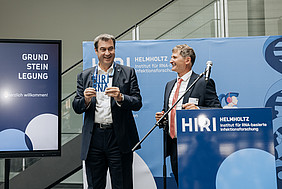With numerous supporters, cooperation partners and companions, the Helmholtz Institute for RNA-based Infection Research (HIRI) Würzburg celebrated the groundbreaking ceremony for its new building on July 6. The facility investigates the great potential of ribonucleic acids (RNA) for the therapy and diagnostics of diseased patients.
At the latest since the coronavirus pandemic, it has become clear that concerning pathogens are among the greatest health challenges of our time - as are increasing antibiotic resistance and chronic infections. The Würzburg-based Helmholtz Institute for RNA-based Infection Research (HIRI), founded in May 2017, has taken on these challenges and is developing new strategies and forms of treatment against infectious diseases based on ribonucleic acids (RNA).
Currently still housed on an interim basis in premises at the Julius Maximilians University (JMU), the institute - funded by the Bavarian Ministry of Economic Affairs and co-financed by the European Union - will receive its own building in order to fulfill its research mission at the Würzburg site on a permanent basis. With the ceremonial groundbreaking, construction work can now begin on the Würzburg medical campus. The new building will provide space for 130 employees on almost 5,000 square meters by 2026.
The Helmholtz Institute for RNA-based Infection Research (HIRI) is the first institution of its kind worldwide to combine ribonucleic acid (RNA) research with infection biology. Based on novel findings from its strong basic research program, the institute’s long-term goal is to develop innovative therapeutic approaches to better diagnose and treat human infections.
"RNA technology offers medically one of the greatest opportunities for mankind"
In his keynote speech to the more than 200 guests from science, business and politics, Bavaria's Minister President Markus Söder explained the importance of Würzburg as a research location for the state's strategy for the future and innovation, in which research and science have priority. He explained that the state was investing in the future - in science for the benefit of mankind. RNA technology offers "one of the greatest opportunities for mankind in medical terms". As part of its high-tech agenda, the Free State of Bavaria is investing over 5.5 billion euros in science and research - according to Söder, "more than any other state."
Under the requirement to construct a new building for the Helmholtz Institute for RNA-based Infection Research in Würzburg that is both forward-looking and economical, the Munich-based office doranth post architekten was awarded the contract in the architectural competition. A striking feature of the new building is the building head on the west side, which is designed as a fifth floor and is intended to emphasize the independence of the Helmholtz Institute on the campus and provide a place for meetings and events.

